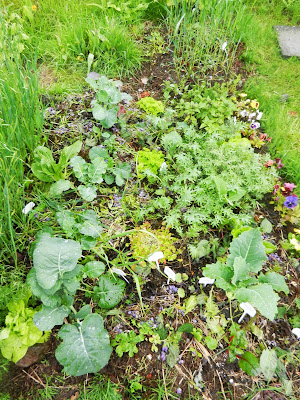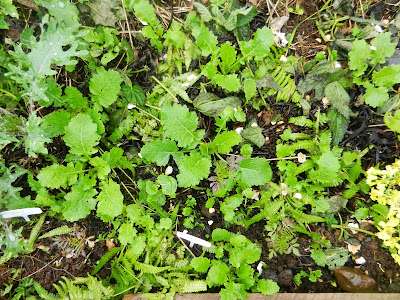July frosts, rain nearly every day
For a few days of the last days we have been having minor frosts at night (lows around 0-3°C) but sunny mild afternoons (highs around 15-18°C). Still it is a cold summer, colder than average, and the squash is just beginning to flower now (too late). The melon plants died, when the temperature first reached 2°C during one of the last nights. But it has rained non-stop for 2 months!
First harvests: kale, pak choy, salads
Still, there are many successes. The pak choy and kale is ready for harvest, so are the salads, the peas and beans are flowering, and the broccoli is just a question of time. Another nice harvest are the strawberries (they grow so well in the Icelandic summer). Chives is another of those perfect crops for Iceland.
Slowly the turnips, leeks and spring onions also seem to be heading to a crop. The swede (swedish turnip) is much faster and it is just beginning to start forming its large root.
The rye and oats are heading and I should have my very first harvest by September. Probably the barley (and the perennial rye) will be heading in the next few weeks, but the wheat seems to be slow, and I don´t think I will get an harvest from it.
 |
| Kale, broccoli, pak choy, salad, parsley, coriander |
Best time for sowing crops
Mid July is also the best time to sow radish (outdoors). Because early sown radish tends to bolt during the 24 hour daylight. It is probably the best time to sow overwintering grains.
The best time for sowing the other crops is late March for broccoli, kohlrabi, leeks, celery, beets, fennel, lettuce and tomatoes (all indoors, for transplant out by June), mid April for lettuce, corn salad and carrots (outdoors), cereals, broad beans, turnips, swedes, pak choy and kale (outdoors or growing indoors for a few weeks) and squash (indoors for transplant out by mid June). Potatoes should be planted out by June.
 |
| Turnips |
The story of a kohlrabi
I might have for the first time (in Iceland) a kohlrabi, it is forming the bulb now, but it was a 2.5 month old transplant in mid June (so best time for sowing it indoors is around late March. The soil where it is planted is the richest - it had a lot of our homemade kitchen compost.
 |
| The kohlrabi |
Weeds as soil indicators - and the secret of a fertile soil
I am using weeds as soil indicators. Where sorrel grows, it indicates an acidic soil, potencially lacking in calcium. If I start to see weeds like chickweed, groundsel and pigweed family weeds, then it means that the soil is as fertile as it should be. This is done just by adding enough compost and ensuring a good soil structure (adding the hollow branches of lupins and angelica, as well as peatmoss and seaweed, really helps!). I also mulch with a lot of nettles, lupins, sweet cicely, ferns, coltsfoot, dandelion and meadowsweet, to see which weed is best cut as a mulch.
 |
| This is a container having hugelkultur; compost, dead wood and branches - the vegetables are growing very healthy and rapidly, because of the good soil structure and soil life. |
Planning new grains for overwinter
I am digging out the last remaining part of lawn in front of our appartment. I am laying soil and compost over it, and around 15-30 July, I plan to sow winter oats, winter rye, triticale, and winter wheat (some new 4m2). I am waiting for the seeds I ordered from
www.bountifulgardens.org. If I can manage to make the plants overwinter, with thick mulching, then I should be able to have a harvest next summer. The challenges in Iceland are both a short, cold and unreliable summer, and the winter with too many cycles of thawing and freezing.
The medicinal plants of Iceland
We have been trying the edible and medicinal uses of many Icelandic native plants. These last days I drunk an infusion of lady bedstraw, greater plantain, we cooked with dandelion and nettles, I ate the leaves of sweet cicely and cuckoo flower (after positive ID)
Warm loving crops and building a plastic windbreak
The siberian tomatoes are just beginning to ripe (but they are so slow that its only for the fun of it). The painted mountain corn is a kind of failure. It grows slowly and if I move a tall plant from the greenhouse, the stems fall with the often windy Icelandic climate. Seems impossible to grow corn in Iceland, even with this variety, which is the best for cold summers.
However, one success story is the quinoa. The quinoa was growing 2 months indoors before being moved out in June, and it is about to begin the flowering stage (which requires cool weather). Hopefully it will produce an harvest sometime in late summer.
I started yesterday to build a simple windbreak and kind of cold frame, or greenhouse. In a sheltered spot near the walls of the house (where I grow the tomatoes), I stuck two pieces of wood and a transparent plastic between them (1 meter high, 2 meters wide). This should produce a greenhouse like microclimate, that should allow me to grow many of the warm loving crops next year.
 |
| Siberian tomatoes cropping outdoors |
Many flowers
After the tulips, daffodils, crocus, scilla, frittilaries and muscari, I have outside pansies, tagetes, centaurea, phacelia, lupins, wild myosotis, wild sedum, roseroot, poppies, water avens, and even a nice clematis and laburnum climbinb against the wall. The flowering brassicas and angelica attract many beneficial insects.
 |
| Flowering broad beans, peas, brassicas, pansies and oats |
Trying perennial vegetables in Iceland
I also abandoned the idea of moving my 1 year trees to the outdoors, after causing them to suffer a cold shock in June. I keep all the mulberries, honey locust and chilean mesquite indoors, as well as the asparagus, since they seem to stop growing in such cool weather. The same happened for the groundnut (and thus I kept one plant in a container indoors). The chinese yams also do not grow outdoors.
I have a feeling that the siberian pea shrub might do fine in Iceland, as well as the good king henry. The crambe is also doing nicely outdoors, but I believe it will not flower this year. All these are growing in a fine way.
Besides that, we have nice patches of strawberries, chives, multiplier onions, walking onions, perennial rye, rhubarb and scotish lovage, all growing very happily in our cold climate. There is a change that the amelanchier (juneberry), mulberry, elaeagnus (silverberry) and pecan, might grow better outdoors.
 |
| Good king henry, a kind of perennial spinach, giving also broccoli like heads and early spring shots like asparagus |


